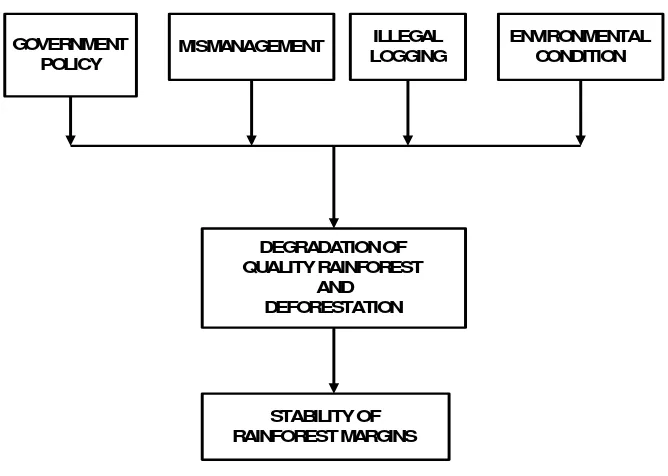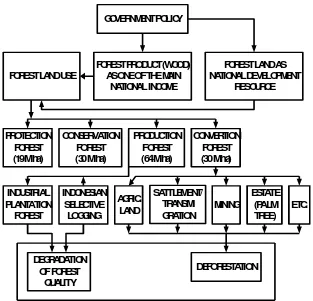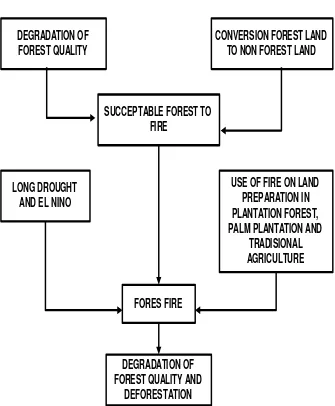Trop. For. Manage. J. VII (1) : 15-22 (2001)
THE STRATEGY TO STOP THE DEGRADATION OF TROPICAL
RAIN FOREST IN INDONESIA AND HOW TO IMPROVE THE
CONDITION
Strategi Menghentikan Degradasi Kualitas Hutan Tropika Basah di
Indonesia dan Bagaimana Memperbaiki Kondisinya
F.GUNARWAN SURATMO*)
ABSTRAK
Deforestasi dan degradasi kualitas hutan hujan tropika di Indonesia dimulai tahun 1960 yaitu sejak diperkenalkan sistem Tebang Pilih Tanam Indonesia (TPTI) terhadap 64 juta ha hutan produksi dan konversi hutan tropika menjadi lahan non-hutan seluas kurang lebih 30 juta ha. Kebijakan pemerintah atau pengambil keputusan, rencana tataguna hutan, kesalahan manajemen perusahaan hutan produksi oleh perusahaan-perusahaan swasta dan penebangan liar telah memicu kerusakan hutan. Bagaimana cara memberhentikan deforestasi dan degradasi hutan, maka perlu dilakukan strategi khusus untuk memperbaiki kondisi hutan seyogyanya dilakukan pendekatan melalui revisi kebijakan pemerintah, penerapan pengelolaan hutan lestari dan perbaikan kondisi ekonomi masyarakat. Stabilitas dari manfaat hutan hujan tropika di Indonesia tidak bisa dicapai apabila degradasi dan deforestasi hutan hujan tropika tidak bisa diberhentikan.
INTRODUCTION
Indonesian tropical rainforest rank third in the world after Brazil and Zaire. Before 1960 it was initially estimated to 164 million ha (1.64 million km2). Total land areas is about 190 million ha, so the forest land area was about 86.3% of total land. With those abundant forest resource, if properly managed with Sustainable Forest Management (SFM) System will be able to supply national need of wood and also international market. Since wood product concept had been changed to forest product concept, the advantages of the tropical rainforest Indonesia will make more margins.
Unfortunately since 1960 it has been happening deforestation and degradation of forest quality in almost all forest areas in Indonesia. It is very interesting to study why and how it has been happening. According to the Director General of Forest Protection and Nature Conservation (1988): 64 million ha had been considered as production forest, 30.5 million ha as protection forest, 18.9 million ha as conservation forest and it was considered 30 million ha as conservation forest.
NEGATIVE IMPACT FROM THE GOVERNMENTAL POLICY
Before 1960 almost all tropical rainforest outside of the Jawa Island had not been exploited. The only forest were exploited is Jawa forest, especially, teak Plantation Forest with large 2.5 million ha or 19% of total land. Since 1960 Indonesia Selective Logging System had been used to exploit tropical rainforest outside Jawa, especially in Kalimantan Island and Sumatra Island. In 1994 it was recorded that 61.7 million ha rainforests has been managed by private companies with Indonesian Selective Logging System and then Changed to be Indonesian Selective Logging and planting system from 18 Concession Units in 1968 to 578 Concession Units in 1994.
Figure 1. Relation between stability of rainforest condition with rainforest margins
Limited monitoring and controlled by the government to the implementation of selected logging have been created a lot of degradation of forest quality, wood production decreased from 63.7 million m3 per year in 1985 to 31.4 million m3 per year in 1989-1994.
To stop degradation of natural rainforest, plantation forest system had been introduced in 1984 and the Government planned to developed about 6 million ha or 100.000 ha per year, but the result forest plantation 1984-2000 is not to promising.
In 1994 from 61.7 million ha production forest estimated will produce 61.7 million m3 per year (growth rate 1 m3 per year/ha). Wood industries had been developed with big capacity especially for plywood industry, sawmill industry, molding industry and forniture industry. Mismanagement by private companies (does not follow sustainable forest
GOVERNMENT POLICY
MISMANAGEMENT ILLEGAL
LOGGING
ENVIRONMENTAL CONDITION
DEGRADATION OF QUALITY RAINFOREST
AND DEFORESTATION
management system) have created degradation of forest quality and supply and demand for
Figure 2. Negative impact from the government Policy
The unbalance condition of wood supply-demand lead to created illegal logging to fulfill the negative supply of wood for industries.
Since the government had considered 30 million ha of rainforest will be changed to non-forest land, deforestation has been occurred, forest land changed to agricultural land, settlement land, mining land, estate land, etc.
about 4 million ha had been approved, 0.62 million ha from production forest and 3.26 million ha from conversion forest and 0.12 million ha from other land (Manurung, 2000). According to Dephutbun (2000) or Ministry of Forestry and Estate crops rate of deforestation in 1985-1998 not less then 1.6 million ha and 1999/2000 estimated increased to 1.7 million ha.
NEGATIVE IMPACT FROM THE MISMANAGEMENT OF THE
PRODUCTION FOREST BY PRIVATE COMPANIES
Sustainable forest Management (SFM) concept is a new concept in Indonesia. Ministry of Forestry introduced this concept in 1993 and it had been taken time for forest managers to implement the concept of SFM and the consequences degradation of forest quality have been accured. In 1990 from 64 million ha of production forest only 37 million ha left in a good condition and also reported that in 1983, 11.8 million ha of production forest land already without forest anymore. Log or wood production has been decreasing steeply.
NEGATIVE IMPACT FROM THE ECONOMIC CRISIS
Indonesia has a big population, in year 2000 estimat already reached 210 million people. During economic crisis from 1997 up to now (year 2000) has been increasing unemployment people included people living around the forest land, and they have been doing illegal logging to support their life a lot of wood industry companies have also been sponsored the activities of illegal logging. The illegal logging have been created deforestation and degradation of forest quality and in the same time law enforcement to individual, group or company who already done illegal logging has been very weak.
NEGATIVE IMPACT FROM FOREST FIRE
Figure 3. Negative impact from the production forest management
Figure 4. Relation of economic crisis and imployment, unbalanced wood supply-demand to illegal logging and degradation of forest quality and deforestation
Figure 5. Relation of forest fire and degradation and deforestation
In the normal condition and in a good forest management forest fire only affected less than 0.001% of the total forest land area, since the government opened the natural rainforest for wood production (Indonesia selective logging), conversion 30 million ha of forest, mismanagement of production forest and illegal logging. It had changed the natural rainforest which is resistance to fire becoming susceptible to fire, and last but not least long drought period (every 10 years) and El Nino phenomena had been created forest fire
DEGRADATION OF
FOREST QUALITY
CONVERSION FOREST LAND
TO NON FOREST LAND
SUCCEPTABLE FOREST TO
FIRE
LONG DROUGHT
AND EL NINO
USE OF FIRE ON LAND
PREPARATION IN
PLANTATION FOREST,
PALM PLANTATION AND
TRADISIONAL
AGRICULTURE
FORES FIRE
DEGRADATION OF
FOREST QUALITY AND
in a large area especially during long drought and El Nino in 1987, 1991, 1994, 1997, 1998 and already predicted that in 2001 El Nino will come again.
Forest fire has been destroying the rainforest in Indonesia seriously. It will be more serious because Indonesia has not enough trained manpower and equipment to prevent and control on forest fire.
THE STRATEGY TO STOP THE DEGRADATION THE
RAINFOREST IN INDONESIA
Before improving the rainforest condition in Indonesia, should be stopped the couses of deforestation and the degradation of forest quality.
The strategy to stop the degradation is to eleminate all causes as follow : 1. Revise the government policy in forest land use
2. Implementating sustainable forest management system
3. Reward and panishment and law enforcement to forest managers, companies, individual and group of people who use the forest from mismanagement and illegal logging
4. Improving the economical condition especially people around the forest 5. Reforestation
6. Strong protection on protection forest and conservation forest 7. Reduced the pressure on natural rainforest such as :
a. wood not as one of the main national income
b. full tree utilization system, this system to minimize wood waste left in the forest (estimated about 60 thousand m3 per year)
c. using lesser known species
d. using species with small diameter ( 50 cm)
e. rationalizen between potential wood industry with potential wood product from production forest
8. Public participation on forest management and introducing private forest program
IMPROVING THE RAINFOREST IN INDONESIA
1. In 1990 estimated that only 37 million ha (58 %) of the production forest is still in good condition, it means about 27 million ha should be improve the condition. According Manurung (2000), 30 thousand ha land in a critical condition should be rehabilited. Illegal logging has been happened also in conservation forest and protection forest, those area should be putted in the first priority in rehabilitation program. It can be concluded that rehabilitation or reforestation program should be done in a very large forest area and will take a long time and a lot of money.
2. Rehabilitate the habitat and improve the fauna population, especially in conservation forest.
CLOSING REMARKS
1. Review and revise the government’s policy, plans and programs on the rainforest land in Indonesia
2. Strong control on private company in implementating of sustainable forest management system
3. Improve the employment and the economical condition of the people especially on people especially on people who live around the forest to stop illegal logging and mest land accupation
4. Control on using fire on shifting cultivation and lan preparation 5. Law enforcement
6. Reforestation on degraded forest
7. Rehabilitation or reforestation on conservation forest and protection forest 8. Rehabilitation on habitat, fauna, biodiversity and forest affected by fire
LITERATURES CITED
Departemen Kehutanan dan Perkebunan, 1999. Statistik Tahunan Pengusahaan Hutan. Ditjen, P.H. Jakarta
Director General of Forest Utilization. 1997. Decree No. 220/IV-BPH/1997 on Implementation Guidelines Industrial Plantation Forest with Selective Logging and Stripe Plantation System. Ministry of Forestry and Estate, Jakarta.
Leighton, M. 1983. The El Nino Southern Oscillation Event in Southeast Asia : Effect of Drought and Fire in Tropical Forest in Eastern Borneo. Dept. of Antrhropology, Harward University
Manurung, EGT. 2000. Pembangunan Perkebunan Kelapa Sawit di Indonesia Ancaman Terhadap Hutan Alam. Warta Fahutan No I/3, Bogor.
Massijaya, M.Y. 2000 Upaya Penyelamatan Industri Pengolahan Kayu Indonesia Ditinjau dari Sudut Ketersediaan Bahan Baku. Warta Fahutan I/3 Bogor
Minister of Forestry, 1995. Decree No. 206/Kpts-II/95 on Technical Guidelines on the Implementation of Industrial Plantation Forest, Jakarta
Minister of Forestry, 1945. Decree No. 464/Kpts-II/1995 on Forest Protection Forest Management, Jakarta
Suratmo, F.G. 1998. The Indonesia Perspective and experience in Forest Fire Management, Tropical Forest Fire (Proceeding), BAPPENAS, Jakarta



